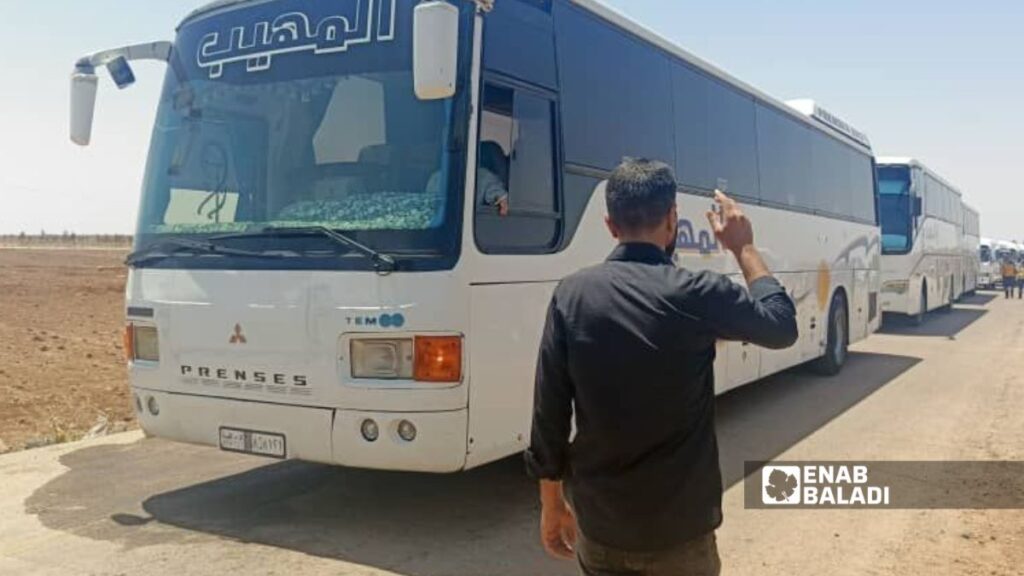
The humanitarian and service situation in Syria’s southern Suwayda province has continued to deteriorate since the security tensions that began on July 12.
Residents in southern Suwayda told Enab Baladi on Sunday, August 10, that the region is experiencing declining public services, shortages of food supplies, and a lack of cash liquidity.
Although the southern villages and towns of the province have not witnessed any armed clashes, they have seen an influx of displaced people from western rural Suwayda seeking safer areas.
Homes and shops in western rural Suwayda have been damaged or completely burned in acts of vandalism, preventing residents from returning.
Aktham Asfour, a resident of Umm al-Rumman in southern Suwayda, described a dire living situation in his village. Basic foodstuffs and essential supplies are scarce, and obtaining them has become nearly impossible, he said.
Each household is allotted only six loaves of bread per day regardless of family size. For weeks, Asfour has struggled to find vegetables for his family of three, managing to obtain no more than a kilogram at a time. Red and white meat have become almost entirely absent from most households in the province.
As for electricity and water, Asfour said the power supply is limited to just two hours a day, while water pumping is minimal, forcing him to rely on his home well for daily needs.
Hamza Allameh, a resident of Suwayda city, described local shop shelves as “almost empty, except for cleaning supplies.” Like others, he struggles to obtain food and essentials, with bread rations now dependent on the availability of flour at the city’s bakeries.
“My wife relies on our household stock—rice, lentils, and bulgur—to feed our family of four,” Allameh said. “But even that is about to run out, and I don’t know what we’ll do when it’s gone.”
Most Suwayda residents are also facing a cash shortage due to halted work and the suspension of money transfer companies in the province since the start of the security unrest.
The UN Office for the Coordination of Humanitarian Affairs (OCHA) reported on July 21 that more than 93,000 people have been displaced due to escalating hostilities in Suwayda—either within the province or to neighboring Daraa and Rural Damascus.
According to its latest update, local communities in Suwayda are hosting most of the displaced in at least 15 reception centers, while some 30 collective shelters have been opened in Daraa. Field partners in southern Syria reported an urgent need for humanitarian aid in Suwayda, with several hospitals and health centers out of service.
OCHA also said that Suwayda’s water infrastructure has been severely damaged, leading to service outages lasting more than a week. Significant electricity cuts have also been reported, along with major disruptions in food and other supply chains.
Aid Falls Short
Despite the continued arrival of humanitarian assistance through the Bosra al-Sham humanitarian crossing in rural Daraa, the aid is not enough to meet the needs of the entire province.
Omar al-Malki, director of media and communications at the Syrian Arab Red Crescent (SARC), told Enab Baladi that humanitarian operations in southern Syria focus primarily on Suwayda, Daraa, and Rural Damascus.
He said the response targets families displaced from their homes—whether from within Suwayda or from outside the province—either staying with host communities, in shelters in Daraa, or in other areas. SARC provides these families, as well as their host communities, with aid.
This includes support for vital sectors such as hospitals, bakeries, and water stations by supplying fuel, flour, and water purification tablets, in addition to providing food baskets, shelter kits, and other assistance to affected residents.
Al-Malki noted that aid distribution prioritizes the most affected families and the most vulnerable groups. Needs vary by area, he said, based on vulnerability assessments.
Several factors influence aid distribution plans, including needs assessments, limited resources and supplies, and accessibility. Security tensions have hindered the entry of relief convoys to certain villages.
Commercial trucks and humanitarian convoys continue to enter Suwayda. The seventh aid convoy, which arrived on August 8, included 27 trucks (19 from SARC and eight commercial), carrying 1,750 food baskets, 1,750 bags of rice, 1,750 bags of lentils, 197 blankets, 197 mattresses, 3,473 personal hygiene kits, 7,618 bags of flour (15 kg each), 429 kg of peanut butter for hospitals, 192.5 tons of flour, and 31,373 liters of diesel fuel, according to the Suwayda governorate.
Three gas tankers also arrived at the Suwayda Fuel Directorate on Sunday, August 10, with a total capacity of about 51,000 liters, to support residents’ basic needs.
“Syrian Arab Red Crescent” Explains Dispute Behind Mesopotamia’s Withdrawal of Suwayda Aid Convoy
The post Limited Resources and Service Gaps: Living Conditions Worsen in Suwayda, Syria appeared first on Enab Baladi.